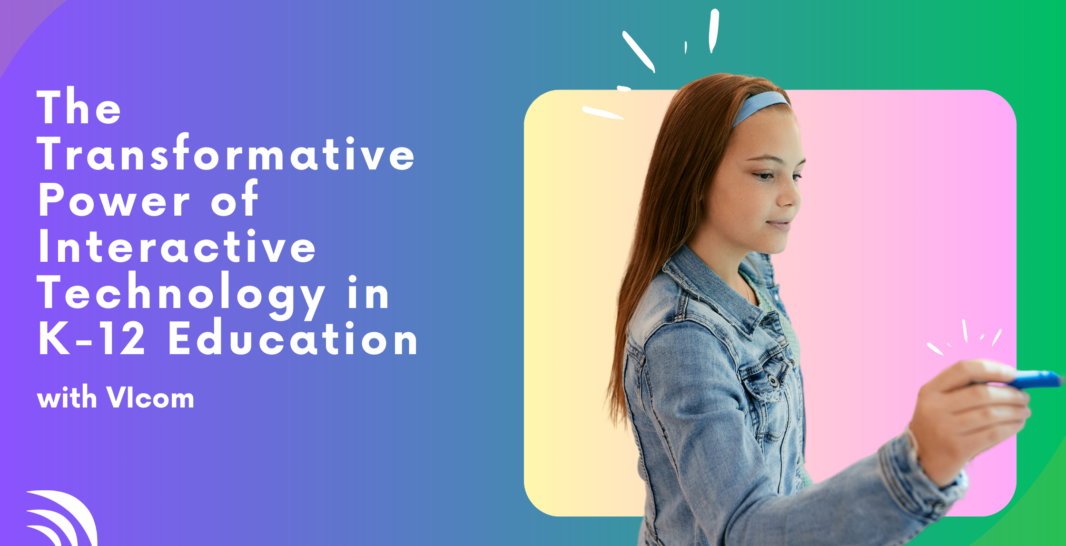The integration of interactive technology in K-12 classrooms has become more than just a trend—it’s a necessity. As we prepare students for a future where technological fluency is paramount, the education sector must adapt to meet 21st-century needs.
At VIcom, we’ve been at the forefront of this educational revolution, supporting schools across Virginia for many years. Our experience with institutions like Norfolk Public Schools, Chesapeake Public Schools, Cape Henry Collegiate, Norfolk Collegiate, Prince William County Public Schools, Isle of Wight Public Schools, and many others has given us unique insights into the transformative power of interactive technology in education. Through our work in thousands of classrooms, we’ve seen firsthand how the right technology solutions can enhance learning experiences and outcomes.
Enhanced Student Engagement: The Gateway to Effective Learning
Picture a classroom where every student is leaning forward, eyes bright with interest. This is the power of interactive technology. Interactive whiteboards and touchscreens have revolutionized the way information is presented, turning passive listeners into active participants.
Recent studies have shown that interactive technology continues to have a significant positive impact on student engagement and academic performance:
- A 2023 meta-analysis found that the use of interactive whiteboards in classrooms led to a 16% improvement in student achievement across various subjects.
- Research published in 2022 indicated that gamification elements in educational apps increased student motivation by 42% and improved retention of learned material by 23%.
Multimedia integration appeals to diverse learning styles, ensuring that whether a student is visual, auditory, or kinesthetic, they can connect with the material in a way that resonates with them.
Personalized Learning: Tailoring Education to Individual Needs
Imagine a world where every student receives instruction perfectly calibrated to their unique learning pace and style. With adaptive learning platforms, this is no longer a pipe dream but a tangible reality. These sophisticated systems analyze student performance in real-time, adjusting content difficulty and presentation to optimize learning outcomes.
The effectiveness of personalized learning through technology has been further validated:
- A large-scale study in 2023 involving over 10,000 students showed that those using adaptive learning platforms improved their test scores by an average of 18% compared to traditional methods.
- Real-time assessment tools were found to reduce the time teachers spent on grading by 40%, allowing them to provide more individualized attention to students.
Collaboration and Communication: Breaking Down Classroom Walls
The ability to collaborate effectively is a critical skill. Digital platforms are transforming group projects, allowing students to contribute ideas, share resources, and work together seamlessly, even when physically apart.
Virtual classrooms are taking this concept global, connecting students across continents and fostering cross-cultural understanding. Shared digital workspaces are the new frontier of teamwork, teaching students not just academic content, but also vital skills in digital collaboration that will serve them well in future careers.
Digital Literacy: Preparing for a Tech-Driven Future
By integrating interactive technology into daily learning, we’re not just teaching subject matter—we’re cultivating digital natives who are comfortable navigating the tech-driven landscape of modern careers. This hands-on experience is invaluable, providing students with the confidence and competence to adapt to new technologies as they emerge.
The importance of digital skills in the job market continues to grow:
- A 2024 report by the World Economic Forum now estimates that 70% of new jobs created in the next decade will require advanced digital skills.
- A survey of employers in 2023 found that 82% consider digital literacy a critical factor when hiring entry-level positions.
Expanded Access to Educational Resources: The World at Their Fingertips
Virtual field trips are expanding horizons in ways previously unimaginable, bringing the world to students who might otherwise never have the opportunity to experience these wonders. Online libraries and educational apps are further democratizing access to information, providing students with a wealth of resources that extend far beyond traditional textbooks.
Increased Accessibility: Education for All
One of the most profound impacts of interactive technology in education is its potential to level the playing field for diverse learners. Assistive technologies are opening doors for students with disabilities, allowing them to participate fully in classroom activities. Language translation tools are breaking down barriers for English language learners, enabling them to engage with content in real-time.
Enhanced Teacher Efficiency: Empowering Educators
Interactive technology isn’t just transforming the student experience—it’s revolutionizing how teachers work. Streamlined lesson planning and delivery tools are freeing up valuable time, allowing educators to focus more on individual student needs. Automated grading systems are reducing the administrative burden, while data-driven insights are enabling teachers to provide more targeted, effective instruction.
Preparing for a Digital Future: Beyond the Classroom
The integration of interactive technology in K-12 education is about more than just improving current learning outcomes—it’s about preparing students for the future. By familiarizing students with the types of technology they’ll encounter in higher education and the workplace, we’re setting them up for success in their future endeavors.
Cost-Effectiveness and Sustainability: A Win-Win Solution
While the initial investment in interactive technology can be significant, the long-term benefits often outweigh the costs. Digital resources reduce the need for physical materials, leading to decreased spending on textbooks and other printed resources. Over time, this can result in substantial savings on educational supplies.
Long-term studies are now showing the financial benefits of interactive technology in education:
- A 5-year longitudinal study published in 2024 found that schools implementing comprehensive interactive technology solutions saw a 22% reduction in overall educational material costs.
- The same study reported a 15% improvement in student retention rates, potentially saving millions in re-enrollment and remedial education costs.
Challenges and Considerations: Navigating the Digital Transition in the Classroom
As we embrace interactive technology in education, we must be mindful of several challenges:
- Ensuring equitable access to technology: Not all students have equal access to devices or reliable internet at home. Schools must work to bridge this digital divide through initiatives like device lending programs and partnerships with local internet providers.
- Addressing privacy and security concerns: With increased digital integration comes the need for robust data protection. Schools must implement strong cybersecurity measures and educate students about online safety.
- Striking a balance between screen time and other learning methods: While technology offers many benefits, it’s crucial to maintain a balanced approach to learning. Educators should incorporate tech-free activities and outdoor learning to promote holistic development.
- Providing comprehensive teacher training: For technology to be effective, teachers must be confident in using it. Ongoing professional development is essential to keep educators up-to-date with the latest tools and best practices.
- Mitigating the risk of technology addiction: Schools should implement policies to promote healthy technology use and teach students about digital wellness.
Emerging Trends: The Future of Interactive Technology in Education
Looking ahead, several emerging technologies promise to further revolutionize education:
- Artificial Intelligence (AI) for even more personalized learning experiences: A 2023 pilot study using AI-powered tutoring systems showed a 30% improvement in math scores for struggling students.
- Virtual Reality (VR) and Augmented Reality (AR) for immersive learning: VR field trips were found to increase student engagement by 45% and improve information retention by 35% compared to traditional methods.
- Blockchain technology for secure and verifiable academic credentials
- Internet of Things (IoT) for creating smart, responsive classrooms
Implementing Interactive Technology: A Roadmap for Schools
For schools looking to implement interactive technology, we recommend the following steps:
- Assess current infrastructure: Conduct a thorough evaluation of existing technology and network capabilities to identify gaps and needs.
- Set clear objectives: Define specific, measurable goals for technology integration aligned with overall educational objectives.
- Start with pilot programs: Begin with small-scale implementations to test effectiveness and gather feedback before full-scale rollout.
- Prioritize professional development: Invest in comprehensive training programs for teachers and staff to ensure confident and effective use of new technologies.
- Engage all stakeholders: Involve teachers, students, parents, and administrators in the planning and implementation process to ensure buy-in and address concerns.
- Monitor and evaluate regularly: Continuously assess the impact of technology integration on learning outcomes and make adjustments as needed.
- Plan for long-term sustainability: Develop a strategy for ongoing maintenance, updates, and replacement of technology to ensure long-term success.
Parent Involvement: Bridging the Home-School Gap
Interactive technology can significantly enhance parent-teacher communication and involvement in their children’s education through digital portfolios, parent portals, and virtual parent-teacher conferences.
VIcom’s Role in Educational Technology Integration
VIcom is an AV, UC and Network and IT integrator with over 20 years of experience working with organizations in Virginia and beyond. We specialize in engineering custom solutions, integrating those solutions, and then providing ongoing support. Our incredible education team is led by Dr. Michael Rossi, who brings decades of experience as a real-world educator and headmaster. Dr. Rossi now specializes in working with schools as an Education specialist for VIcom, bringing a unique blend of pedagogical expertise and technological know-how to our educational solutions.
Our comprehensive approach includes:
- Custom solution design tailored to each school’s unique needs and goals
- Seamless integration of new technologies with existing systems
- Ongoing support and maintenance to ensure optimal performance
- Professional development to empower educators in leveraging new technologies effectively
Embracing the Future of Education
As we look to the future, it’s evident that interactive technology will play an increasingly central role in education. By embracing these tools and approaches now, we’re not just improving current educational outcomes—we’re preparing students for success in a digital world.
At VIcom, we’re committed to partnering with educational institutions to navigate this exciting transition. Together, we can create learning environments that not only meet the needs of today’s students but prepare them for the challenges and opportunities of tomorrow.
Are you ready to be part of this transformative journey? Contact VIcom today to explore how we can bring the power of interactive technology to your school and help shape the future of education.

